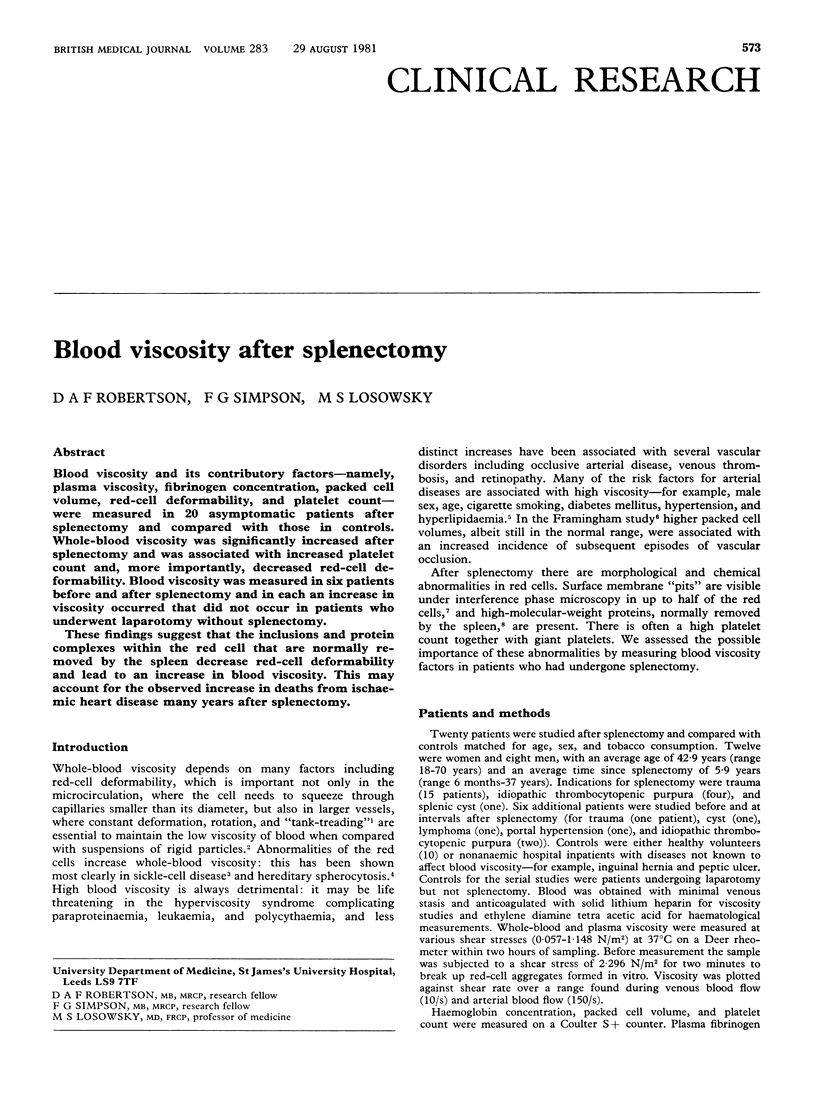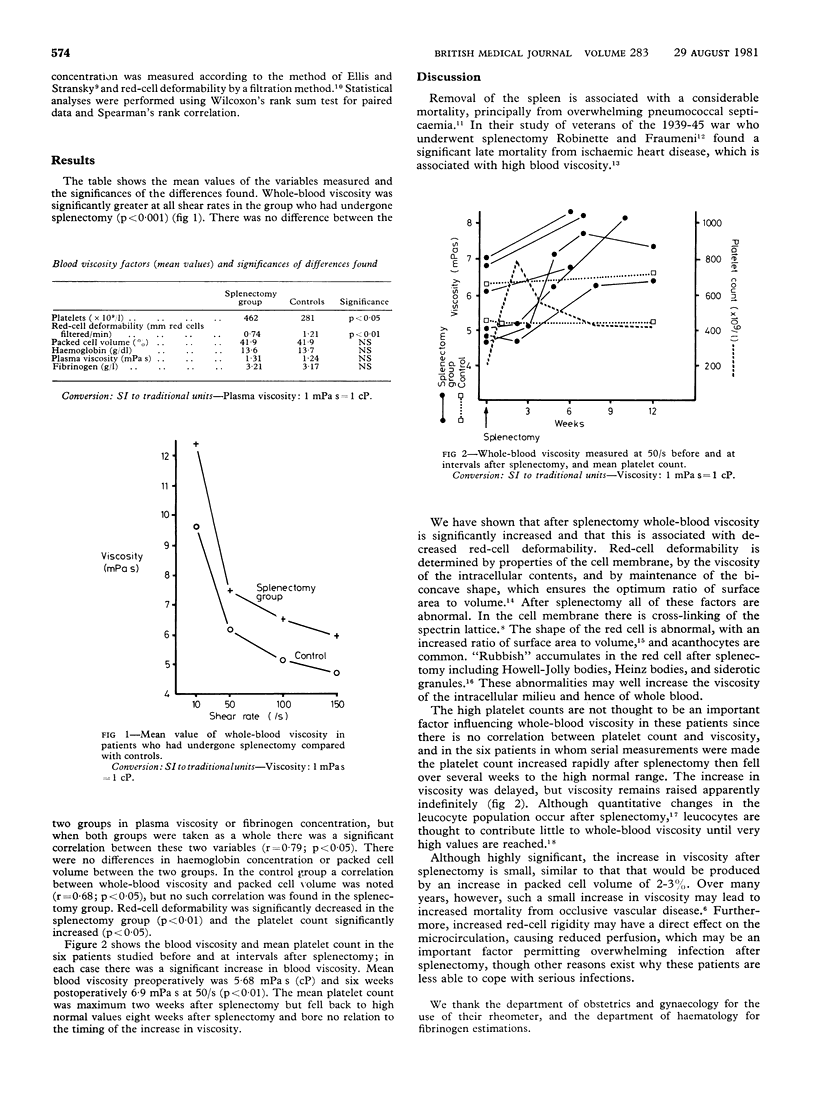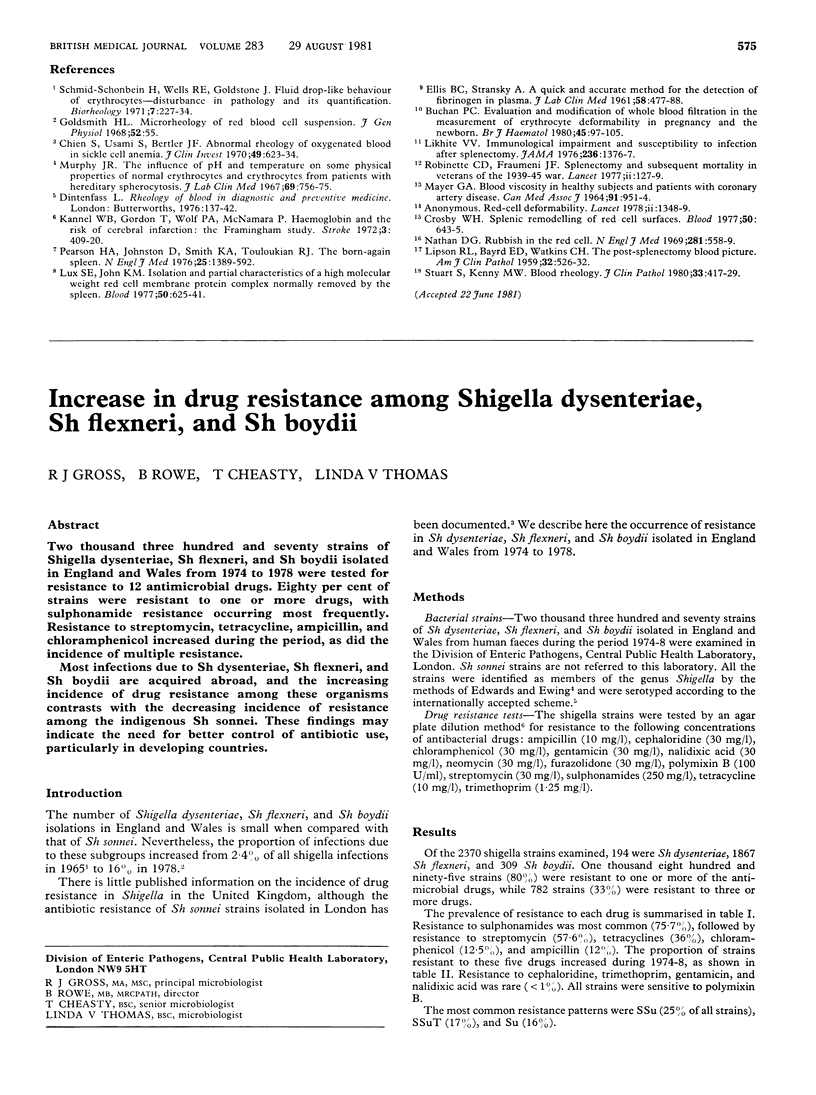Abstract
Blood viscosity and its contributory factors--namely, plasma viscosity, fibrinogen concentration, packed cell volume, red-cell deformability, and platelet count--were measured in 20 asymptomatic patients after splenectomy and compared with those in controls. Whole-blood viscosity was significantly increased after splenectomy and was associated with increased platelet count and, more importantly, decreased red-cell deformability. Blood viscosity was measured in six patients before and after splenectomy and in each an increase in viscosity occurred that did not occur in patients who underwent laparotomy without splenectomy. these findings suggest that the inclusions and protein complexes within the red cell that are normally removed by the spleen decrease red-cell deformability and lead to an increase in blood viscosity. This may account for the observed increase in deaths from ischaemic heart disease many years after splenectomy.
Full text
PDF


Selected References
These references are in PubMed. This may not be the complete list of references from this article.
- Buchan P. C. Evaluation and modification of whole blood filtration in the measurement of erythrocyte deformability in pregnancy and the newborn. Br J Haematol. 1980 May;45(1):97–105. doi: 10.1111/j.1365-2141.1980.tb03815.x. [DOI] [PubMed] [Google Scholar]
- Chien S., Usami S., Bertles J. F. Abnormal rheology of oxygenated blood in sickle cell anemia. J Clin Invest. 1970 Apr;49(4):623–634. doi: 10.1172/JCI106273. [DOI] [PMC free article] [PubMed] [Google Scholar]
- Crosby W. H. Splenic remodeling of red cell surfaces. Blood. 1977 Oct;50(4):643–645. [PubMed] [Google Scholar]
- ELLIS B. C., STRANSKY A. A quick and accurate method for the determination of fibronogen in plasma. J Lab Clin Med. 1961 Sep;58:477–488. [PubMed] [Google Scholar]
- Kannel W. B., Gordon T., Wolf P. A., McNamara P. Hemoglobin and the risk of cerebral infarction: the Framingham Study. Stroke. 1972 Jul-Aug;3(4):409–420. doi: 10.1161/01.str.3.4.409. [DOI] [PubMed] [Google Scholar]
- LIPSON R. L., BAYRD E. D., WATKINS C. H. The postsplenectomy blood picture. Am J Clin Pathol. 1959 Dec;32:526–532. doi: 10.1093/ajcp/32.6.526. [DOI] [PubMed] [Google Scholar]
- Likhite V. V. Immunological impairment and susceptibility to infection after splenectomy. JAMA. 1976 Sep 20;236(12):1376–1377. [PubMed] [Google Scholar]
- Lux S. E., John K. M. Isolation and partial characterization of a high molecular weight red cell membrane protein complex normally removed by the spleen. Blood. 1977 Oct;50(4):625–641. [PubMed] [Google Scholar]
- MAYER G. A. BLOOD VISCOSITY IN HEALTHY SUBJECTS AND PATIENTS WITH CORONARY HEART DISEASE. Can Med Assoc J. 1964 Oct 31;91:951–954. [PMC free article] [PubMed] [Google Scholar]
- Nathan D. G. Rubbish in the red cell. N Engl J Med. 1969 Sep 4;281(10):558–559. doi: 10.1056/NEJM196909042811013. [DOI] [PubMed] [Google Scholar]
- Robinette C. D., Fraumeni J. F., Jr Splenectomy and subsequent mortality in veterans of the 1939-45 war. Lancet. 1977 Jul 16;2(8029):127–129. doi: 10.1016/s0140-6736(77)90132-5. [DOI] [PubMed] [Google Scholar]
- Schmid-Schönbein H., Wells R. E., Goldstone J. Fluid drop-like behaviour of erythrocytes--disturbance in pathology and its quantification. Biorheology. 1971 May;7(4):227–234. doi: 10.3233/bir-1971-7406. [DOI] [PubMed] [Google Scholar]
- Stuart J., Kenny M. W. Blood rheology. J Clin Pathol. 1980 May;33(5):417–429. doi: 10.1136/jcp.33.5.417. [DOI] [PMC free article] [PubMed] [Google Scholar]


